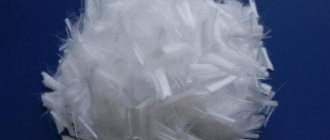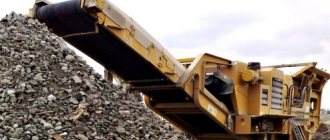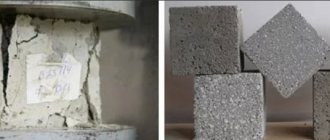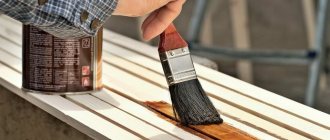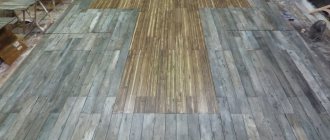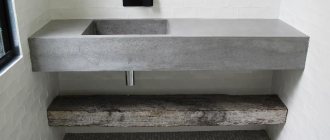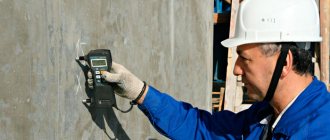Formwork is used to construct all elements of the building. It is made from various materials, taking into account the design features of the building, the climatic characteristics of the region where the house will be located and some other parameters. Therefore, foam formwork is often used to fulfill all the conditions during the construction of a building. It not only fits almost all construction characteristics, but also significantly reduces the time required to build a house.
What and how to paint polystyrene foam?
Foam plastic is used for both internal and external work. It is used for heat and sound insulation of walls, ceilings and partitions, and also for the manufacture of elements for decorative finishing of premises. Sometimes painting foam is necessary for aesthetic purposes. This is not easy to do, since the material requires special technology.
Table of contents:
Paint selection
Not every type of polystyrene foam can be painted. For example, laminated decorative elements are covered with a protective layer, which prevents the pigment composition from being absorbed and evenly fixed on the surface. In any case, paint intended for foam plastic must have:
- Good adhesion.
- Elasticity.
- Water resistant.
- Resistant to ultraviolet radiation and aggressive environments.
Most often, water-based and acrylic suspensions are used for painting. The first ones impress with their low cost, but are absolutely defenseless against moisture and get very dusty, so they are used only for interior work. Their price ranges from approximately 25 to 40 rubles/l. Acrylic solutions demonstrate increased resistance to aggressive environmental influences, but are more expensive (from 50 to 500) and less durable. The choice of one type of paint or another is mainly determined by the location of foam products: outside or inside buildings.
Painting technology
Elements of interior decor are usually painted with a water-based suspension. It has sufficient viscosity to close the pores of the material with a uniform layer. Before painting tiles, baguettes and rosettes, they must be cleaned of dust and lint with a clean, dry cloth. All joints and seams are filled with putty or sealant. In order to paint a foam ceiling plinth with high quality, to achieve a uniform and rich color, it is recommended to cover it in several layers, be sure to wait until each one is completely dry.
The brush should be moved in one direction - this will avoid streaks and drips. However, for processing decorative jewelry with small and complex relief, this painting option is ineffective. It is easier to use a spray gun, which provides quick and uniform coverage of the material with pigment. It is advisable to paint ceiling moldings and foam cornices before gluing them, so as not to stain the wallpaper.
How to paint foam on the outside of a building?
It is fundamentally important that the paint for polystyrene foam boards that insulate external walls has elasticity, resistance to atmospheric conditions and temperature changes. The choice of modern paints and varnishes for exterior use is quite wide, but almost all of them contain aggressive substances that destroy the material. Therefore, before painting the foam, you need to cover its surface with a protective layer. For this purpose, solutions of sodium or potassium silicate, which are also called liquid glass, are usually used.
Before applying to the foam, they should be diluted and then stirred vigorously to avoid clumps. It is recommended to add not water to the composition, but a primer, which makes it more elastic and smoothly levels the surface.
It is also possible to cover the foam with a thin layer of liquid putty. After drying, you can begin painting it with any acid-containing composition.
termoframe.ru
Primer for foam plastic - types and application
Recently, cladding the external walls of buildings from foam has become increasingly popular. Such measures make it possible not only to carry out external repairs, but also, more importantly, to increase the heat-saving properties of the structure. In order for the work on insulating external walls to be carried out efficiently, you need to know which primer is suitable for polystyrene foam.
For exterior and interior use, the priming (and primer) of the foam is different, be careful
Since the work takes place entirely outdoors, it is necessary to use construction and finishing materials of appropriate quality and purpose. Installation and finishing solutions must have certain operating temperatures, moisture and heat resistance, strength and durability. That is, their task is to provide reliable protection of surfaces under the influence of atmospheric phenomena.
Let us note that experts in construction and repair issues definitely recommend using primer mixtures at intermediate stages. How and how to prime a foam surface, more on that later.
Types of primer mixtures
Primer mixtures differ in quality (composition), properties, and purpose. There are universal solutions suitable for both different types of work and for treating surfaces of various structures. Basically, all compositions are divided into strengthening and adhesive.
- Strengthening agents are used on porous structural surfaces. The main properties of such solutions are deep penetration into the base layers (up to 10 cm deep), the formation of a firmly protective film after drying.
- Adhesive solutions are applied to surfaces before plastering and other types of decorative cladding in order to improve the adhesion of materials. That is, here the primer serves as an intermediate layer that improves the physical and technical qualities of the finish.
The composition of the primer can be alkyd, acrylic, glyphthalic, phenolic, polystyrene, polyvinyl acetate, perchlorovinyl. Both the performance qualities of the solution and the possibilities of its use already depend on the composition.
For facade work, a material with the following properties is used:
- increased water resistance;
- moisture resistance;
- frost resistance;
- heat resistance;
- deep penetration, but also excellent grip;
- chemical inertness;
- biological inertia;
- ability to resist and neutralize efflorescence.
Primed polystyrene foam has a number of advantages, including the saving of solutions subsequently applied to it.
For the initial treatment of surfaces before applying the subsequent coating, a primer is simply necessary. Decorative wall cladding will subsequently hold up much better. In addition, deep-penetrating primer mixtures prolong the durability of base materials and improve their technical characteristics. Another useful property is a reduction in the consumption of subsequent solutions applied over the primer (glue, putty, paint, varnish).
Priming when insulating walls with foam plastic
Before attaching foam plastic to the walls, you need to do a number of preparatory work. It is imperative to clean off the old decorative coating, no matter what it is. Check the surface for damage.
Next, it is recommended to apply a deep-penetrating primer. Such preparatory work is especially important when reconstructing the facades of old buildings. This will not only compact the structure of the construction materials, but will also provide protection from further destruction. A material with a dense structure (for example, brick) is primed once, porous mineral materials - from two times.
After the primer has dried, seams and cracks are sealed. Next, the starting profile is installed and you can proceed to gluing the insulation boards (foam plastic). When all the foam boards are glued, they are additionally fixed in the corners with dowels (after the glue solution has almost completely dried). Then a layer of reinforcing mesh is attached to protect the coating from destruction. All this is covered with a layer of adhesive solution and left until tomorrow. The next day you need to repair the unevenness.
Before plastering, the surface is sanded and primed (you can read about how to properly prime walls before plastering here). A mixture is used that increases the adhesive properties of finishing materials. Next, a leveling layer of plaster is applied. Before grouting, it must dry (1-4 days). Grouting is carried out until a perfectly flat surface is formed.
But that's not all. Now you need to apply the decorative (finishing) finishing material. To ensure that the finish sticks well, we will use a primer again. Depending on what exactly the decorative coating will be, the composition of the primer mixture is selected.
This is how foam plastic is primed during façade insulation of walls. By the way, in some cases, foam insulation is installed not outside, but inside the room. There are some peculiarities here, for example, installation mixtures and solutions for intermediate work must be selected taking into account the permissibility of the application.
Rules for applying the primer mixture
- The mixture used must be diluted and mixed thoroughly. Breeding instructions are indicated on the packaging.
- Application can be done with a paint brush or a regular brush. Sometimes by roller or by spraying. After completing work, tools must be cleaned.
- The primer layer must dry well. Once dried, it will become resistant to mechanical damage.
- Do not neglect personal protective equipment.
By observing the manufacturability of finishing work, polystyrene foam wall insulation will perform its protective and insulating function for a long period. Again, cosmetic repairs and restoration of the facade will not be needed for a long time.
kraska.guru
How to paint polystyrene foam - is it possible and with what paint, recommendations
Why paint foam?
Foam-based products are used for both interior and exterior finishing and insulation work. It is used for heat and sound insulation of interior floors, partitions and walls, and in addition, many parts for decorating the interior of premises are produced from it. Often in the process of finishing work there is a need to paint polystyrene foam for one reason or another.
The first thing you need to think about is why paint polystyrene foam at all? This operation is performed in two cases:
- Firstly, to create the effect of visual completeness and a holistic, harmonious interior, which consists of a combination of finishing elements, both among themselves and with the style of the room. It is unlikely that there will be connoisseurs of an interior in which white material with a bubble texture would be present as decor. Most, as a last resort, will prefer another type of finishing material that would fit more harmoniously into the decoration, please the eye and be combined with the surrounding environment. But polystyrene foam has too significant advantages over other finishing materials, especially in terms of price and ease of installation, that, as a rule, it is more rational to cover it with a paint coating than to look for a replacement in the form of another material.
- Secondly, a significant reason for painting is undoubtedly the need to protect it from the destructive effects of an aggressive external environment. For example, from exposure to bad weather in the form of precipitation, temperature changes, stormy winds and, ultimately, banal physical deformation of the material. All these factors seriously reduce the lifespan of foam products. As a rule, an unprotected foam coating very quickly, literally in one season, loses its original appearance.
Thus, applying paint and varnish to polystyrene material can be considered a logical continuation of finishing and decoration work.
What to paint
Construction foam is deservedly considered one of the most versatile materials. It is used for insulation, cladding and as a material for the manufacture of most decorative elements.
At the same time, due to its low cost, products made from it have an affordable price:
- Ceiling tiles based on polystyrene foam are an excellent choice as a finishing material for the ceiling, providing an aesthetic appearance and not requiring major investments. It is not afraid of water, so it can be installed in rooms with high humidity, such as a kitchen or bathroom, but unprotected foam itself is very fragile and can be easily damaged even by accident with bare hands. In addition, under the influence of direct sunlight, such tiles will certainly fade and acquire a yellowish tint.
- Also, foam panels are one of the most popular and widespread options for organizing thermal insulation of the walls of residential buildings. As a rule, they cover the outer parts of the house, its facade, which, unlike the premises inside the building, is constantly exposed to the negative influence of nature in the form of frost, ultraviolet radiation, and precipitation. Therefore, such a coating, which has a relatively fragile structure, requires not only careful handling during installation, but protection in the form of a paint coating for the period of operation.
- Today, very often for interior decoration, skirting boards are used for the ceiling, made on the basis of foam plastic. When purchasing, the color of such a decorative element is usually white. But often it is not the most suitable for a particular interior, and almost always the uncoated material is not very practical. Therefore, in some cases there is a need to change its shade to something other than white. In addition, sometimes the surface of such a plinth has defects, which can be especially visible after installation, when the light in the room is on. In this case, painting is the only alternative to redoing all the finishing work and replacing the baseboard. It will not only mask imperfections, but also add strength to decorative elements. One of the features of the plinth that is conducive to painting it is that during its installation, joints are formed between its different parts, which have to be primed with putty, and in order to hide all traces at the final stage, the plinth is covered with paint along the entire perimeter. Sometimes the need for painting arises suddenly, some time after installation, for example, after a roof leak, when stains appear on the white decor that cannot be cleaned. Then either buy and replace decorative elements, or paint everything and forget.
Paint requirements
Despite the huge variety of types of polystyrene-based foam, there is a problem of its compatibility with paints and varnishes. The fact is that this material is susceptible to the negative effects of organic solvents, precisely those that are part of most paints and varnishes. Thus, in order to coat a foam product with paint and give its surface a beautiful structure, without harm to the material itself, you need to know the features of its compatibility with different coloring compositions.
Expanded polystyrene is resistant to most substances; it can be coated with mixtures of bitumen, lime solutions with water, and also painted with compositions that have a water-dispersion base. But compounds included in the class of organic solvents, for example, ethyl acetate, toluene or the well-known acetone, present in many types of paints, cause a change in the properties of this material, leading to its softening, shrinkage and ultimately dissolution.
Therefore, paints and varnishes for polystyrene-based materials must meet the following general requirements:
- the absence in their composition of substances capable of dissolving foam plastics;
- increased adhesion coefficient to penoplex and PSB;
- stability under the influence of destructive atmospheric factors, insolation;
- providing an aesthetic elastic coating.
Painting foam
In most cases, paints based on water emulsion and acrylic suspension are used for painting foam plastic. The choice of one type of paint or another depends on the location of the foam materials: inside or outside the building.
Inside the building
Inside the building, water-based paints and varnishes are almost always used. They are characterized by low cost, about 25-40 rubles per liter, but are unable to withstand moisture and heavy dust, which determined their specific use only for indoor spaces.
When applying such paint to the interior decorative elements of a room, the optimal viscosity of the paint is ensured, allowing you to hide the pores in the material under a uniform layer of coating. Before painting ceiling tiles, moldings, baseboards and rosette decorations, it is recommended to wipe them from cobwebs and dust with a dry cloth.
The joints between elements and technological seams are puttied or sealed with special compounds. To ensure a high-quality, uniform coating with a rich color on the ceiling plinth made of foam plastic, it is recommended to paint it in several layers, without fail starting to apply the next layer only after the previous one has completely dried.
Painting is usually done with a brush and roller. However, in the case of painting decorative elements with a thin and intricate relief, not a brush is used, but a spray gun, which allows you to quickly apply a uniform layer of coloring pigment to the material. To avoid paint getting on the wallpaper, it is best to paint the moldings and foam cornices before installing them.
Outside the building
On the outside, acrylic-based solutions are used, which are highly resistant to the influence of aggressive external environments, but they are much more expensive - from 50 to 50 rubles and are not durable. That is, they need to be updated from time to time.
For the use of paints as a coating for polystyrene foam boards that provide thermal insulation for the external walls of a house, the characteristics of increased elasticity, resistance to precipitation and contrasting temperature changes are very important.
Modern paint and varnish materials provide a wide choice for organizing outdoor work, but, unfortunately, almost all of them contain aggressive components that corrode polystyrene foam products. Therefore, before regular painting, the foam material is coated with an additional protective layer of sodium or potassium silicate solution, called liquid glass in the professional environment.
This composition is first diluted with water or a primer, due to which it acquires increased elasticity. Thorough mixing is required until a homogeneous consistency without lumps is required.
Another protective coating option for polystyrene materials is a thin layer of putty, after drying, which can be painted with any paint containing acid.
Tips/Tricks
- To prevent streaks and drips from appearing on the foam, you should always move the brush in one direction.
- If you are painting the baseboards that have already been installed on a wall decorated with wallpaper, it is recommended to use masking tape to protect them.
- If it is not possible to use paint that does not contain solvents or gasoline to paint polystyrene foam, you can always use a layer of ordinary plaster to protect it. This way, corrosive chemicals will be isolated from the material.
0.00, (ratings: 0)
househill.ru
Instructions for insulating house floors with foam plastic
These include: We advise you to read our article on how to insulate a foundation using polystyrene foam for more details. To become more familiar with the savings achieved by using foam formwork, we will calculate the approximate cost of constructing walls. Calculations are carried out on the basis of the current cost of the material; more details about this are at the end of the article and the dimensions of the building itself. An approximate calculation of the required materials will look like this:.
And if we proceed from prices in Moscow, then approximate calculations for the construction of one floor will look like this, the cost of the work itself is not included:. It turns out that the total cost of all consumables for one floor will average thousands of rubles.
Foam blocks for construction can act as an independent or auxiliary building material. A house made entirely of foam plastic was recently built in Alaska. The building technology is quite simple. The design design is implemented using standard slabs and blocks of expanded polystyrene. They are given the necessary shapes, adjusted to size, placed on top of each other and welded. Then the structure is covered on both sides with slabs of a cement-based mixture.
Such houses have proven themselves well in extreme conditions. Perhaps they will appear in Russia, but for now, in our country, foam blocks are used for construction as insulating material or in the form of permanent formwork.
This fairly new building material quickly gained popularity, especially among individual developers. And there are many explanations for this - high quality, simple technology for laying blocks, and their reasonable cost.
Where is it used?
But there is one more thing - the opportunity to make polystyrene concrete with your own hands directly at the construction site, which is much more convenient and economical than importing finished products. In addition, this allows you to erect structures of any shape and size, without relying on standard ones, by pouring the mixture into prepared formwork.
After the construction of the foundation is completed, you can begin to insulate it. And for this, expanded polystyrene slabs, or, more simply, polystyrene foam, are the best choice. So, in this article we will touch on this topic - insulating the foundation with polystyrene foam. So, first of all, it should be noted that experts say that there is simply no better material for insulating the foundation. Since polystyrene foam is able to perfectly combat the destructive effects of groundwater and movement.
Preparation of the mixture. There are many opinions on this issue, sometimes the most contradictory. Therefore, this article should be considered as advisory, general material. The composition depends on how the polystyrene concrete will be used.
The general recommendation is given in the table:. There are other opinions. Cement - kg grade not lower than M And here is another recommendation. If D wall is being prepared, then sand is added - kg. You can either do it manually or use the simplest equipment for the production of polystyrene concrete - a concrete mixer.
In the first case, it is most convenient to mix the composition in an old bathtub or large trough.
Currently, many individual developers take care of careful insulation of walls and roofs, but often insufficient attention is paid to floor insulation in a private house. There is a wide range of thermal insulation on the building materials market. One of the most common methods of thermal protection has become floor insulation using polystyrene foam.
The technology is the same as for preparing conventional concrete. Cement and sand are poured and water is added. In addition, some use tree resin with soap, others use tar.
The resulting composition is mixed with shovels, and after achieving a homogeneous consistency, foam granules are added. The solution is constantly rising from the edges and pouring into the center.
After that - cement. After another 1 minute - resin and the rest of the water. The total operating time of the mechanism should not exceed 5 minutes. When independently preparing polystyrene concrete blocks on your own, you need to take into account a number of points: If the operating conditions of expanded polystyrene comply with the norm, then its strength only increases over time.
You can rationally save money on this. Masters claim that the expected quality can only be achieved through sampling and personal experience. Even industrially prepared polystyrene concrete often does not meet the stated characteristics. Foam blocks make it possible to simply and inexpensively build houses with a different number of floors. The light weight of foam materials ensures fast and inexpensive transportation of workpieces to construction sites.
Modern foam blocks, the price of which is low, make it possible, due to the listed advantages, to increase the service life of the building’s load-bearing structures. The company delivers materials exactly on time. Besides mixing cement mortar with concrete chips, there are other ways to combine concrete with foam. Here you need to immediately make an important note - it is advisable to use extruded polystyrene foam.
Although this material is more expensive than polystyrene foam, it significantly exceeds it in its performance characteristics: And, in addition, due to its higher density, this material has a longer service life than foam plastic. Another advantage of this method appears when installing heated floors. Due to the fact that polystyrene foam does not allow heat to pass through, their efficiency increases significantly.
In addition, you can insulate the walls with foam sheets. However, this method is best used only for exterior work with subsequent finishing.
If you cover the walls with foam plastic from the inside of the room, you may encounter the problem of condensation. This is another option for combining these materials. The method is that the formwork for the construction of the building structure is constructed from polystyrene foam. And then everything is reinforced and filled with cement mortar. In addition, the walls are well insulated. The only negative is that subsequent finishing of the facade is required.
Carpet Recos Steppe, medium pile 3 m Carpets R. Exhibition carpet Office Floor with backing Carpets R. Exhibition carpet Exporadu Belgium rs 2 m Carpets R. Foam plastic is not one material, but a whole class of them, the distinctive feature of which is a foamed cellular structure. For thermal insulation work in a frame house, the following types of foam plastic can be used:.
Post navigation
Each of these types has its own specifics, and its use is appropriate under certain conditions. Standard foam plastic has several basic criteria, such as density and purpose: for walls, plinth, foundation, and the like. Density determines the main parameters of foam plastic - thermal conductivity; the higher the density, the better the thermal insulation properties and strength, which are in the same progressive relationship.
And also this parameter determines the price and scope of the foam. For example, PPT is relatively soft and cannot be used for floor insulation.
PPT is considered universal, having the highest characteristics, due to which it can be used everywhere, but its price is also the highest.
Foam varnish for painting concrete floors
Due to numerous requests in the comments to my videos, today I will try to make a composition of polystyrene foam and solvents for application to concrete. I would like to see how it will behave, because car owners are interested in cheap varnish to cover the garage against dampness. I’ll start by dissolving polystyrene foam in gasoline. I should also check it in acetone and solvent, but I think that acetone dries too quickly. I pour 92 gasoline into a clean, empty metal can. You will need a little more than half the can of gasoline. I cut a piece of polystyrene foam approximately 1500 mm long and 40 mm thick into strips and lower them one by one into a jar of gasoline. The width of the strip should be chosen according to the size of the can. My goal is to see how the resulting composition will behave on concrete (I don’t need a lot of varnish). The polystyrene foam easily enters the can, melts and compresses into a fairly dense lump at the bottom. Note: in this case, gasoline will bubble and splash out of the can. The resulting composition has the appearance of a gel and is similar to napalm (when ignited, it immediately flares up, burns for a long time, the flame is high). It is not possible to regulate the viscosity of the composition by adding gasoline - it reaches a certain thickness and the process stops there. I leave the jar for a while so that the air bubbles come out and all the pieces of foam dissolve.
Covering the concrete floor
I take out the gel-like mass from the bottom of the jar and transfer it to another container. I clean the area of the concrete slab with a wire brush and blow off dust with a spray gun. I prepared a brush and a spatula for work, which I lightly greased with oil. This way the varnish will not stick. It turned out to be more convenient to work with a spatula. I pour the varnish onto the concrete and with a spatula I begin to apply it to the surface with movements in different directions. After finishing the job, there is practically nothing left on the spatula. When applying the varnish you immediately smell the smell of gasoline. I leave this area for about an hour to dry.
Dissolving polystyrene foam in xylene
I will conduct the second experiment with xylene (one liter costs 110 rubles).
If you cover the entire garage with this composition, then its cost will be 2.5 times more expensive than polystyrene foam varnish dissolved in gasoline. To dissolve in xylene, I chose denser and more expensive fine-grained foam, from which the protection of the computer system unit is made. When xylene is added to the jar, the foam dissolves almost completely, the viscosity of the composition becomes less, and the thick lump disappears. A composition of this viscosity can be applied in a much thinner layer. It looks like xylene is better for making foam varnish. Note: I was also advised to use solvent 647, but I didn’t have it on hand.
I'll try using xylene as a wood varnish. I take a walnut branch peeled from the bark and apply a thin layer of the composition with a brush. It turns out very well, but you need to wait for the varnish to dry. I also apply a layer of the composition onto the concrete with a brush. The layer turns out to be very thin and there are no air bubbles in it. I leave it to dry. The first section did not dry completely in an hour - a film with a very large number of bubbles formed on the surface. Huge bubbles formed on the sides. To the touch it looks like the well-known packaging film with bubbles. However, as an option, this composition can be used after complete drying. The area coated with xylene varnish turned out better. The composition is well absorbed into the surface of the concrete and looks like real varnish. The only negative is the high cost of xylene compared to gasoline. To reduce the cost, you can first dissolve the foam in gasoline, and only then add xylene and achieve the desired viscosity. It will be inexpensive to prepare a composition based on bottled xylene, which is sold in cans and costs less.
Note: the composition dried on wood in 10 minutes and is indistinguishable from real varnish. In the future, for an experiment, I can take a board polished on a machine from a nearby furniture workshop and apply 3-4 layers of xylene varnish to it.
Watch the video
sdelaysam-svoimirukami.ru
The price of the block form is RUB 950,000.
In the block mold, foam blocks are formed. The foam block is formed under the influence of water vapor. When heated, PSV-s granules begin to increase in volume. Since the block form is a closed structure, the PSV-s balls begin to solder (stick together) to each other. The main difference between an automatic block mold and a mechanical block mold is the presence of only one opening lid (door). Due to this, steam losses during molding are reduced to a practical minimum. In addition, the automatic mold can operate in full automatic mode, that is, all the functions of the workers are reduced to removing the finished foam blocks from the mold.
The block form BF-1.0 AUTO is a frame made of steel channel. The inside of the frame is lined with perforated aluminum. The outside of the frame is sheathed with 4mm iron without perforation. The use of aluminum makes it possible to reduce to zero the effect of the finished foam sticking to the walls of the mold. The block mold has one opening side door through which the finished foam block is unloaded. The block mold is equipped with a system for automatically filling the chamber with raw materials. The filling system only works in conjunction with a vacuum station (not included in delivery). The block mold is equipped with an automatic steam supply system into the chamber. The block mold is equipped with an automatic pusher that pushes the finished foam block out of the block mold. Opening and closing of the door of the block form occurs automatically.
All block molds for block (sheet) foam have allowance on all sides. This is done to obtain sheets of ideal geometry. After molding the foam block, residual expansion processes may occur in the PSV-s granules. This may cause some deformation of the block. After molding, all irregularities in the block are cut off on a foam cutting machine, which makes it possible to obtain foam sheets of ideal geometry. All trimmings are subject to recycling in a proportion of 5 - 10% of fresh raw materials. The full production cycle of one foam block takes no more than 4 minutes. The opening and closing of the mold, the block pusher, and the loading valves are driven by pneumatic cylinders. Normal operation of the block mold is impossible without compressed air.
The control panel of the block form is fixed on the body. The control panel consists of several control units for individual functions, as well as a control unit for the entire form. The block form control panel includes the following functions:
1. Opening\closing door block form
2. Opening/closing block-shaped lock
3. Loading the block mold \turning on the vacuum station
4. Supply steam alternately from different walls of the block mold
5. Turn on/off vacuum cooling
6. Pushing out the finished block
All processes have manual and automatic operating modes with the possibility of step-by-step programming. In this case, it is possible to intervene in the automatic process and switch to manual control. Installation of the block form should be carried out under the supervision of our technologist!!!
Delivery set of block mold series BF-1.0 AUTO:
1. Assembled block form
2. Passport block form
The compressor and vacuum station are not included in the delivery package.
On request, the block form of the BF - AUTO series can be made of any size. For example, for the production of SIP panels.
Technical characteristics of block molds series BF
| Dimensions of the resulting block LxWxH mm | 2020x520x1020 |
| Volume of the resulting block, m3 | 1,07 |
| Dimensions when assembled block form LxWxH mm | 4500x1000x2500 |
| Dimensions when disassembled for transportation LxWxH mm | 2500x700x1800 |
| Weight of block form kg | 1100 |
| Productivity, m3/hour | 10-15 |
| Steam consumption per 1m3 of foam plastic, kg | 15-40 |
| Maximum pressure, atm | 12 |
| Working pressure, atm | 5-6 |
| Cooling | vacuum |
| Drives | pneumatic |
| Weight of the resulting foam, kg | 9-40 |
The warranty on the block form is 1 year.
Watch other videos on the operation of our equipment.
Installation supervision required. Click to view terms and conditions.
Price 950,000 rub.
